Briefly: In our opinion, speculative short positions (150% of the full position) in gold, silver and mining stocks are justified from the risk/reward point of view.
Last week was full of action – gold moved below $1,210 only to rally above $1,240 and then to slide back below $1,225. Fortunately, there are a few sings that can tell us which of these moves was the “true” direction in which metals and miners are likely to move in the following weeks.
These signs are the key medium-term indicators and the relative performance of gold vs. the USD Index. Let’s take a look at the charts starting with gold (charts courtesy of http://stockcharts.com).
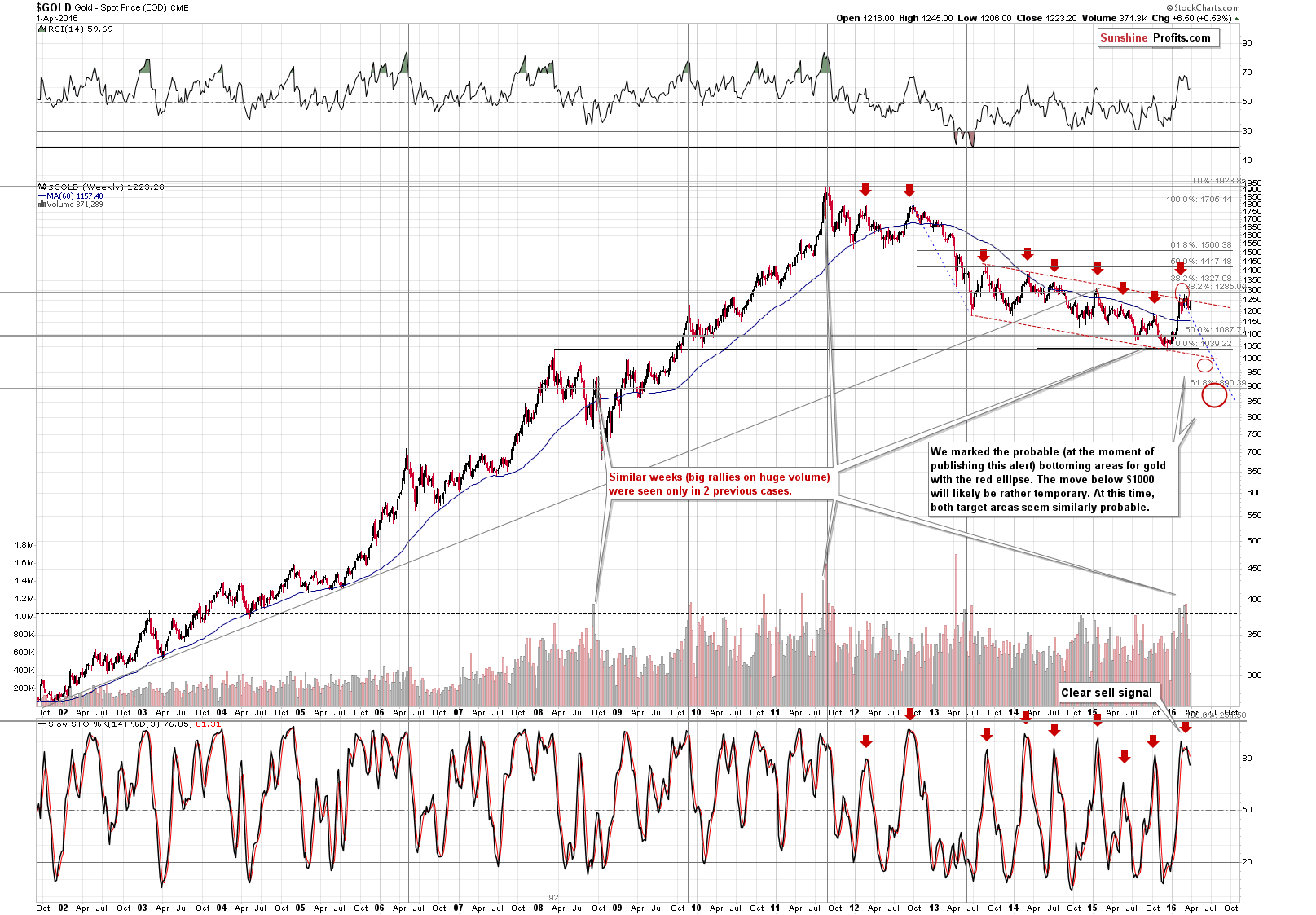
Once again there are no changes on the long-term gold chart and our previous comments remain up-to-date:
From the long-term perspective, nothing happened yesterday, just like nothing happened after Tuesday’s session, so the outlook remains just as it was before this week began – it remains bearish.
The sell signal from the Stochastic indicator remains clearly visible and gold remains within the declining trend channel.
Gold moved $6.50 higher last week, but this move higher was too small to change anything on the above chart – the sell signal from the Stochastic indicator clearly remains in place.
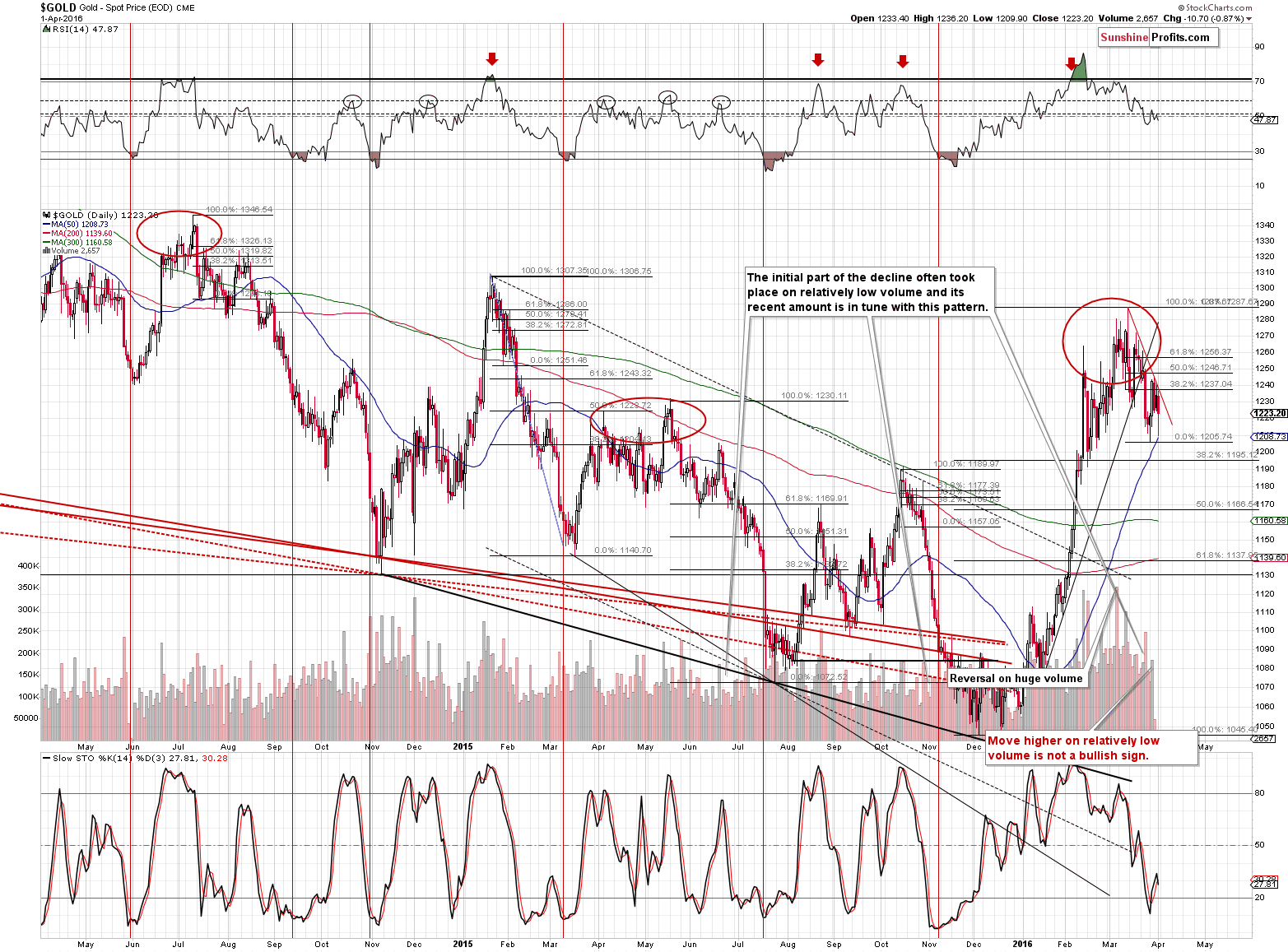
We previously wrote the following:
As far as the short term is concerned, the trend remains down as well. Gold declined and practically erased Tuesday’s rally. The market participants seem to have realized that actually nothing changed based on Yellen’s recent comments and things are returning to normal after some very short-term volatility. Speaking of volatility, we could see some more of it on Friday before and right after the employment numbers are released. This is not likely to change the current trend, which remains down.
We have indeed seen increased volatility on Friday, but overall not that much changed – there was no breakdown below the previous March low and there was no breakout above the declining short-term support line and the lowest (38.2%) of the Fibonacci retracement levels. Consequently, the previous downtrend remains in place.
Consequently, nothing really changed and the outlook remains bearish.
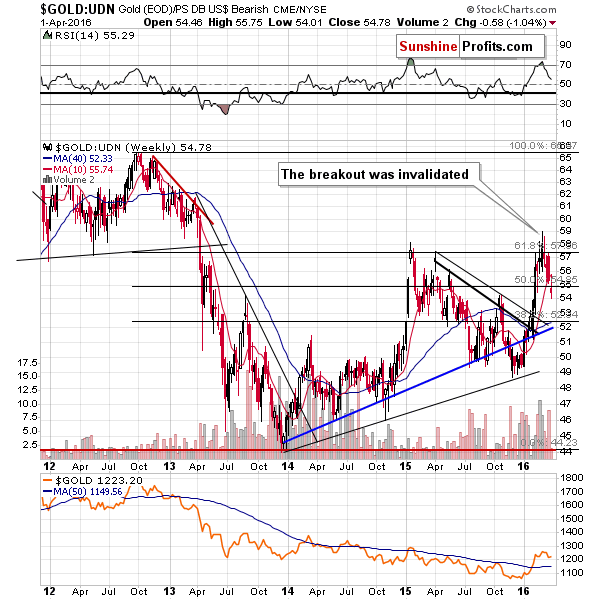
From the non-USD perspective (the average of gold prices in terms of currencies other than the USD) gold appears to have topped after an unsuccessful attempt to break above the 2015 highs. The outlook remains bearish.
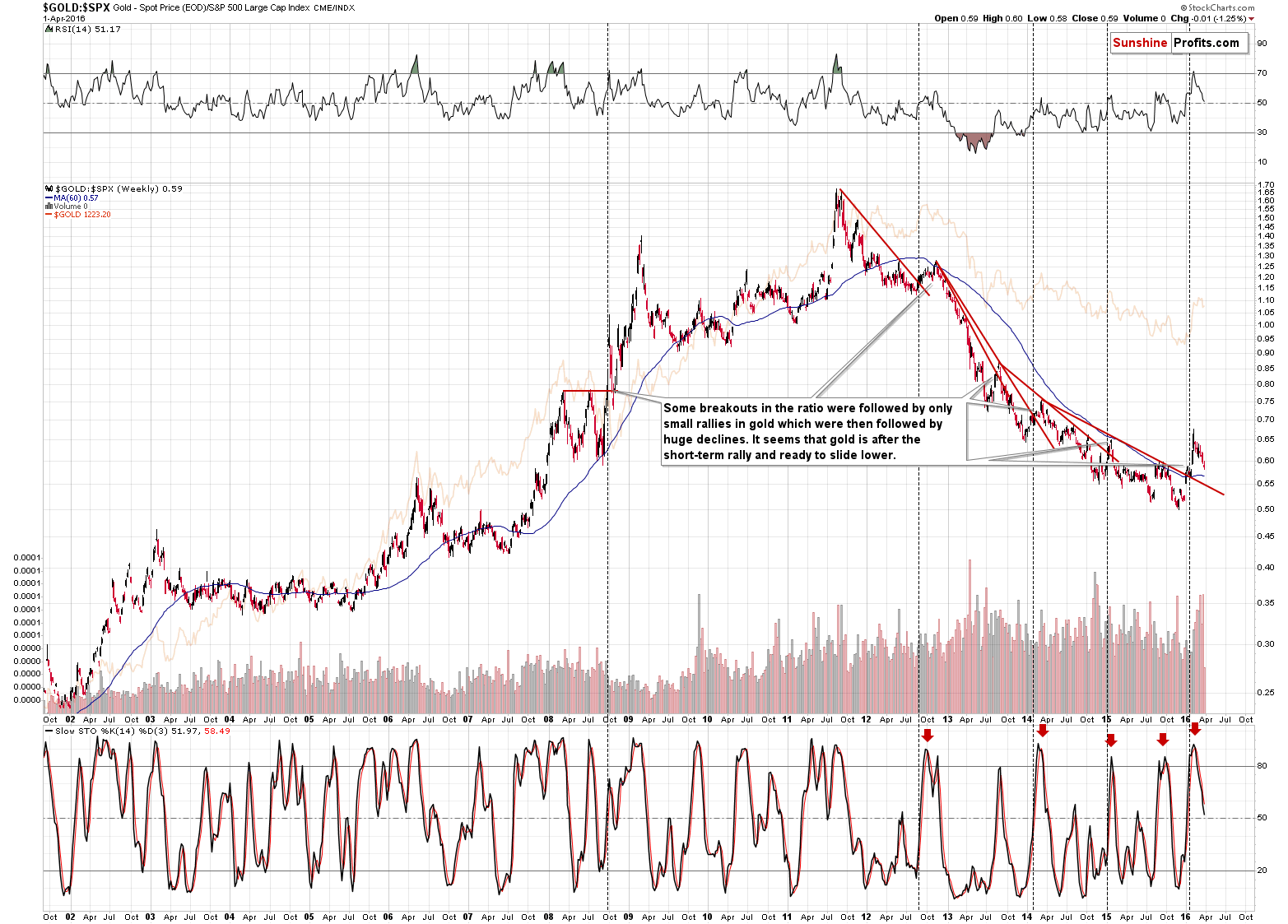
The price of gold compared to the value of the S&P 500 Index was early to flash a sell signal from the Stochastic indicator and the RSI. The important thing at this time is that once the sell signal had been given by the Stochastic indicator when it was overbought (over 80), there were no visible upswings until the decline was quite significant. Please take a look at what happened in the previous cases after similar sell signals (we marked them with red arrows). In each case the decline that followed was at least twice as big as the recent decline. Naturally, this does not imply that the decline will be twice as big as what we have seen so far. It implies that it’s likely that it will be much bigger than what we’ve seen so far, before the first visible corrective upswing is seen (after which the decline could very well continue – which appears very likely).
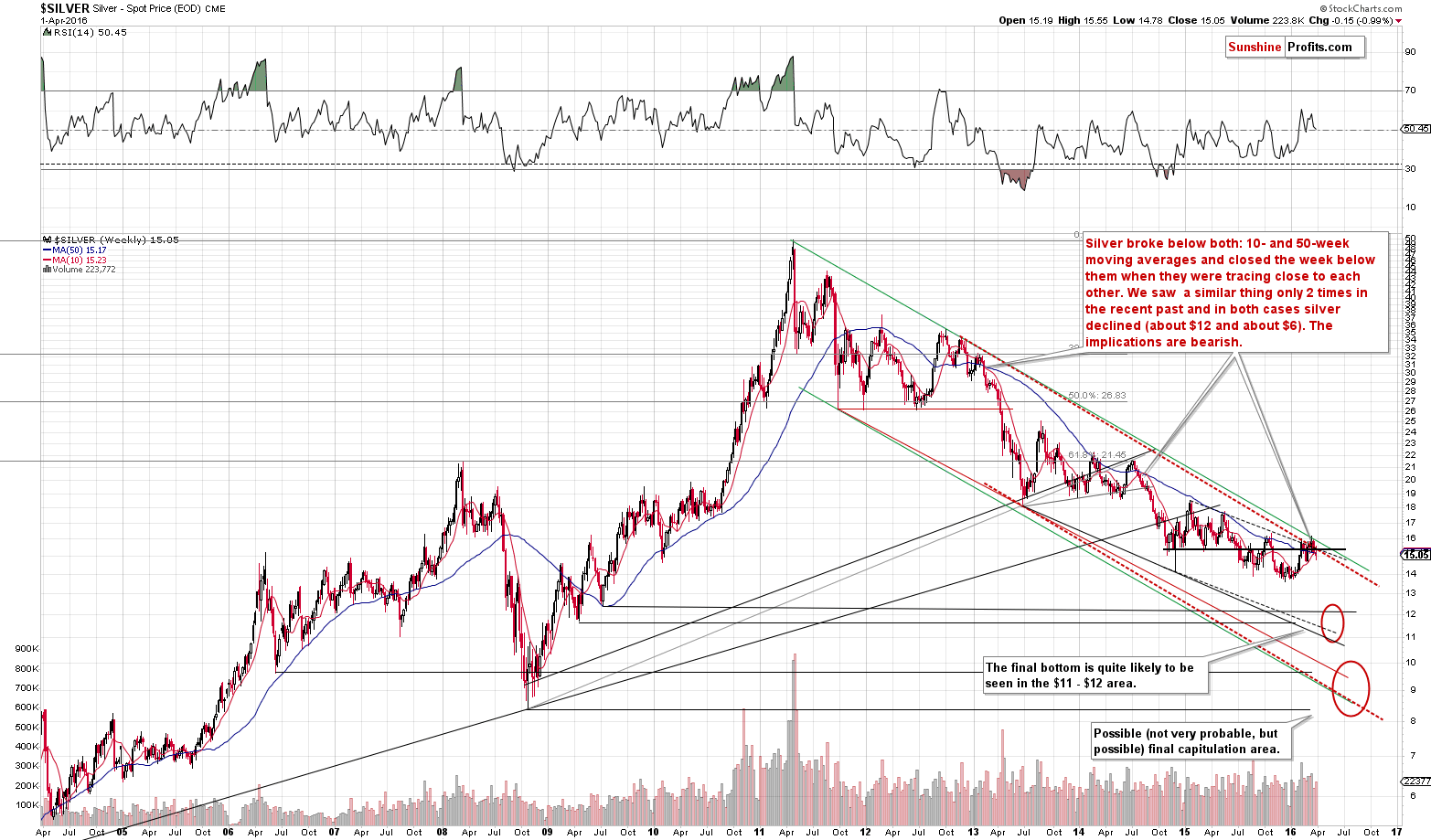
As far as silver is concerned, we saw the decline’s continuation and most importantly, we saw a breakdown below both the 10-week and 50-week moving averages. This is so important, because the last 2 times when we saw such breakdowns and both of them were close to each other, silver declined $12 and $6, respectively. Naturally, the implications are bearish - it appears that silver is about to move much lower in the coming weeks.
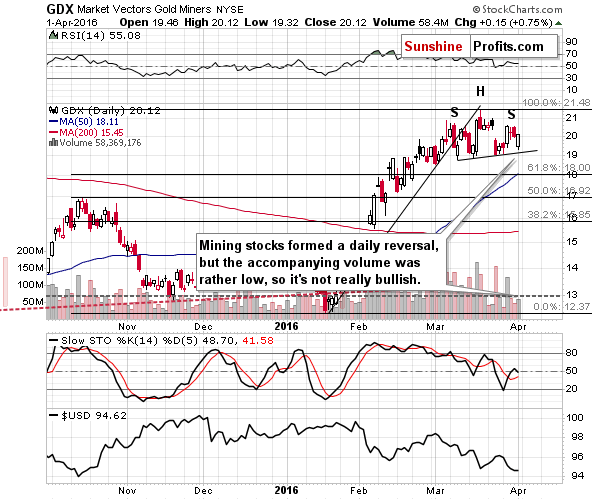
Mining stocks formed a daily reversal on Friday, which seems to be bullish at the first sight, but it actually isn’t. There are 2 reasons: the action in the main stock indices and the volume. The general stock market reversed very visibly and closed the week above the previous highs. It is likely that the miners’ “strength” is simply a reaction to this rally. The size of the volume confirms it – it was low, which is something that is not seen during important reversals, but during pauses. Consequently, we don’t view the action in miners as bullish.
Before summarizing, let’s take a look at what happened in the USD Index.
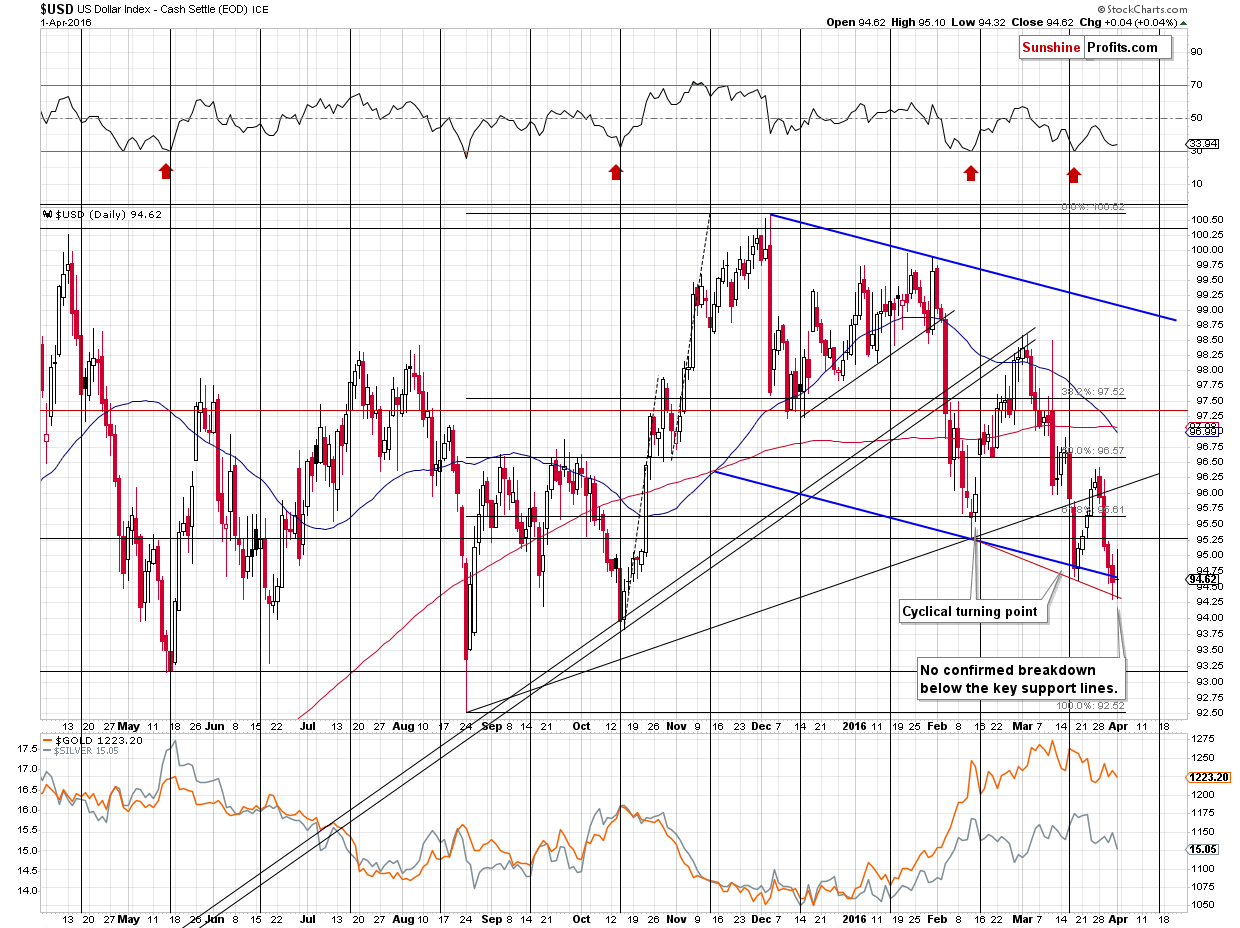
In yesterday’s alert, we wrote that the key thing was that the move below the most important support lines was tiny and the breakdown is not confirmed. This remains to be the case also today. At the moment of writing these words, the USD Index is at about 94.80, which means that the breakdown was invalidated. The implications are bullish for the USD Index and bearish for the precious metals sector, especially that the latter reacted recently quite well to the USD’s rallies but not to the USD’s declines.
Our previous comments on the gold-USD link remain up-to-date:
The link between the precious metals market and the USD Index continues to have bearish implications as at the same time: the USD is likely to move higher and metals are likely to respond to the USD’ rally quite significantly whereas if the decline in the USD continues (which is unlikely but possible), metals are not likely to rally far and such a rally would not likely be sustainable.
Summing up, the outlook for the precious metals sector remains bearish. The long-term sell signals remain in place and we saw a new one in the case of silver (a breakdown below 10- and 50-week moving averages) while at the same time the “strength” seen in mining stocks doesn’t seem to be a reliable sign due to the general stock market’s performance and relatively low volume. Consequently, we think that a speculative short position is currently justified from the risk to reward point of view.
As always, we will keep you – our subscribers – updated.
To summarize:
Trading capital (our opinion): Short positions (150% of the full position) in gold, silver and mining stocks are justified from the risk/reward perspective with the following stop-loss orders and initial target price levels:
- Gold: initial target price: $973; stop-loss: $1,304, initial target price for the DGLD ETN: $90.29; stop-loss for the DGLD ETN $48.27
- Silver: initial target price: $12.13; stop-loss: $16.62, initial target price for the DSLV ETN: $71.92; stop-loss for DSLV ETN $36.89
- Mining stocks (price levels for the GDX ETF): initial target price: $9.34; stop-loss: $22.57, initial target price for the DUST ETF: $7.60; stop-loss for the DUST ETF $2.16
In case one wants to bet on junior mining stocks' prices (we do not suggest doing so – we think senior mining stocks are more predictable in the case of short-term trades – if one wants to do it anyway, we provide the details), here are the stop-loss details and initial target prices:
- GDXJ ETF: initial target price: $14.13; stop-loss: $31.23
- JDST ETF: initial target price: $14.14; stop-loss: $4.05
Long-term capital (our opinion): No positions
Insurance capital (our opinion): Full position
Plus, you might want to read why our stop-loss orders are usually relatively far from the current price.
Please note that a full position doesn’t mean using all of the capital for a given trade. You will find details on our thoughts on gold portfolio structuring in the Key Insights section on our website.
As a reminder – “initial target price” means exactly that – an “initial” one, it’s not a price level at which we suggest closing positions. If this becomes the case (like it did in the previous trade) we will refer to these levels as levels of exit orders (exactly as we’ve done previously). Stop-loss levels, however, are naturally not “initial”, but something that, in our opinion, might be entered as an order.
Since it is impossible to synchronize target prices and stop-loss levels for all the ETFs and ETNs with the main markets that we provide these levels for (gold, silver and mining stocks – the GDX ETF), the stop-loss levels and target prices for other ETNs and ETF (among other: UGLD, DGLD, USLV, DSLV, NUGT, DUST, JNUG, JDST) are provided as supplementary, and not as “final”. This means that if a stop-loss or a target level is reached for any of the “additional instruments” (DGLD for instance), but not for the “main instrument” (gold in this case), we will view positions in both gold and DGLD as still open and the stop-loss for DGLD would have to be moved lower. On the other hand, if gold moves to a stop-loss level but DGLD doesn’t, then we will view both positions (in gold and DGLD) as closed. In other words, since it’s not possible to be 100% certain that each related instrument moves to a given level when the underlying instrument does, we can’t provide levels that would be binding. The levels that we do provide are our best estimate of the levels that will correspond to the levels in the underlying assets, but it will be the underlying assets that one will need to focus on regarding the sings pointing to closing a given position or keeping it open. We might adjust the levels in the “additional instruments” without adjusting the levels in the “main instruments”, which will simply mean that we have improved our estimation of these levels, not that we changed our outlook on the markets. We are already working on a tool that would update these levels on a daily basis for the most popular ETFs, ETNs and individual mining stocks.
Our preferred ways to invest in and to trade gold along with the reasoning can be found in the how to buy gold section. Additionally, our preferred ETFs and ETNs can be found in our Gold & Silver ETF Ranking.
As always, we'll keep you - our subscribers - updated should our views on the market change. We will continue to send out Gold & Silver Trading Alerts on each trading day and we will send additional Alerts whenever appropriate.
The trading position presented above is the netted version of positions based on subjective signals (opinion) from your Editor, and the Tools and Indicators.
As a reminder, Gold & Silver Trading Alerts are posted before or on each trading day (we usually post them before the opening bell, but we don't promise doing that each day). If there's anything urgent, we will send you an additional small alert before posting the main one.
=====
Latest Free Trading Alerts:
The U.S. economy added 215,000 jobs in March. What does it imply for the Fed policy and the gold market?
March Payrolls Report and Gold
S&P 500 index extended its short-term uptrend on Friday, as investors' sentiment further improved following economic data releases. Will it reach last year's highs above the level of 2,100? Or is this still just an upward move within almost year-long slightly descending trading channel?
Stock Trading Alert: New Short-Term Highs As Investors Await Quarterly Earnings Releases
=====
Hand-picked precious-metals-related links:
Gold falls after robust U.S. jobs report boosts risk sentiment
Gold Lovers Bet Party Isn't Over After 17% First-Quarter Surge
New Saudi gold mine starts producing
=====
In other news:
Dennis Gartman: Stay neutral on stocks
'Panama papers' leak spells danger for offshore tax havens, world leaders
Why JGB yields won't keep falling deeper into negative yield
Greece says bailout review must be concluded immediately
Trove of data on offshore accounts prompts probe, questions
World central bank arsenals in spotlight
IMF Internal Meeting Predicts Greek 'Disaster', Threatens to Leave Troika
=====
Thank you.
Sincerely,
Przemyslaw Radomski, CFA
Founder, Editor-in-chief, Gold & Silver Fund Manager
Gold & Silver Trading Alerts
Forex Trading Alerts
Oil Investment Updates
Oil Trading Alerts



